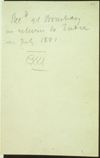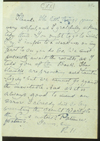Mahatma Letter No. 19: Difference between revisions
No edit summary |
No edit summary |
||
| Line 32: | Line 32: | ||
{{Col-begin|width=98%}} | {{Col-begin|width=98%}} | ||
{{Col-break|width=55%}} | {{Col-break|width=55%}} | ||
Received at Bombay on return to India | Received at Bombay on return to India in July 1881. | ||
{{Col-break|width=3%}} | {{Col-break|width=3%}} | ||
Revision as of 12:38, 18 February 2014
| Quick Facts | |
|---|---|
| People involved | |
| Written by: | Koot Hoomi |
| Received by: | A. P. Sinnett |
| Sent via: | unknown |
| Dates | |
| Written on: | unknown |
| Received on: | July 6-11, 1881 See below. |
| Other dates: | none |
| Places | |
| Sent from: | unknown |
| Received at: | Bombay, India |
| Via: | none |
This is Letter No. 121 in Barker numbering. See below for Context and background.
< Prev letter chrono
Next letter chrono >
< Prev letter Barker
Next letter Barker >
Cover sheet
|
Received at Bombay on return to India in July 1881. |
NOTES: |
Page 1 transcription, image, and notes
|
Thanks. The little things prove very useful, and I gratefully acknowledge them. You ought to go to Simla. TRY. I confess to a weakness on my part to see you do so. We must patiently await the results, as I told you of the Book. The blanks are provoking and "tantalizing" but we cannot go against the inevitable. And as it is always good to mend an error I already did so by presenting the Occult World to the C----'s notice. Patience, patience. Yours, ever |
NOTES:
|
Context and background
Physical description of letter
The original is in the British Library, Folio 3. According to George Linton and Virginia Hanson, the letter was written:
On a single sheet of rippled white paper, in blue ink. The sheet is about 4" X 6" [10.2 X 15.2 cm] in size, folded note style. The capital "P" in "Patience" near the end of the letter is heavy, and the ink has blotted near the top of the sheet where the paper was folded.[1]
Publication history
Commentary about this letter
Notes
- ↑ George E. Linton and Virginia Hanson, eds., Readers Guide to The Mahatma Letters to A. P. Sinnett (Adyar, Chennai, India: Theosophical Publishing House, 1972), 64.

